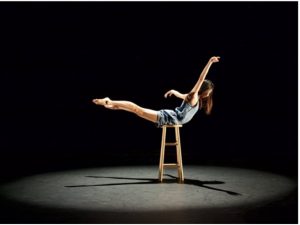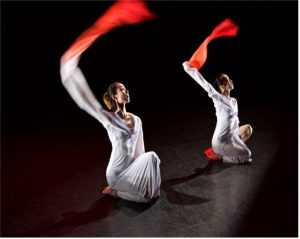16 An Yi
Nikki Ontiveros
An Yi
Narrative and Interview by Nicolette Ontiveros

An Yi’s early dance training was difficult and left emotional and physical pain. Starting dance classes at the age of seven in Dalian, China. An Yi took dance classes in a small room with 7-8 other students. She said, “Everything in the room looked normal, but nothing connected me with the word dance.” In China, dance is different than in the United States, she said. The rigorous training can physically and mentally hurt children’s bodies. Yi talked about there being a bed in the studio that the kids would get stretched on by the instructor. Students would lie on their backs and have one leg pressed against the floor with force and the other leg forced to their faces. They would count to 10 when told to as a cue to know when to switch legs. “I counted in a painful voice but with determination and hope in my mind,” she said. Eventually, her mom took her out of class after finding out that Yi would take her grandmother’s sleeping pills before class in order to cope.
Beginning in 2004, Yi trained for five years at Beijing Opera Art College at the age of 12, leaving her family behind in their hometown. There, she took Chinese dance, folk dance, technique, and repertory courses, and, in the last year, she took contemporary and music theories. She had to grow up oddly fast at such a young age, receiving a dorm key, payphone card, and a student ID at age 12. Though in a better environment than before, Yi trained at this school and gained that spark again to eventually grow her passion for dance. Like in any school, these students were required to take general curricular classes like Chinese, math, history, English, politics, and geography.
In 2011, Yi was admitted to the Beijing Dance Academy (BDA), after being denied entrance twice before. Majoring in Han and Tang Chinese dance at BDA was nothing but excitement to Yi. She knew the skills she was learning would be useful: bone bead shoe sewing, Han dynasty hair making, Han makeup, and costume designing.
There is a twelve-hour time difference between Yi’s home in China to the University of North Carolina in Greensboro (UNCG), where she took her first contemporary technique class. Yi took all of her knowledge from her training into class, but everything was unfamiliar. “I placed my back on the marley floor, arms open to the side, without a leotard, bun, or shoe on my body.” Working with B.J. Sullivan at UNCG, Yi worked hard in dance class and to figure out the big changes that came from moving to a different country. Overcoming language barriers and the significant cultural uniqueness, Yi figured it out. Learning about Laban Movement Analysis with Dr. Mila Parrish and learning the importance of body atmosphere and placement were critical to her development as a dancer. Giving presentations in a classroom, Yi would practice and choreograph her speeches before presenting. Yi said, “My dance experience in China educated me that classroom space is a sacred stage, movement learning, and body polishing as core in the class, which resulted in the classroom practice being undervalued and underdeveloped. However, the instructor often asked why and how questions that failed all my preparations in this real classroom phenomenon and challenged my choreographic mind and socialist dancing body in a way that never existed [for me before].”
“I remember one audience member came to me and said: Your choreography is beautiful!! I presented a Chinese Water sleeve solo piece in that show, and I do not think many of the audience members really understood and accepted this because of the cultural differences. But one lady said this to me very honestly and appreciated it.”
I interviewed An Yi in 2022 and was surprised and delighted by what she had to share about her remarkable career and life.

What has been your biggest achievement in your dance career?
An: Two different dance education systems since I was born and raised in China and attended full-time dance training when I was 12. I was experienced in professional dance training and all the different dance styles in China. But after I graduated from my undergraduate school, I decided to pursue an MFA in the US. I think that changed my previous perspective on dance teaching and learning, especially regarding the relationship between the students and the dance teachers. After I received different dance styles such as contemporary jazz, it opened my body and mind, which also shaped my teaching, my scholarship, my performance, and my choreography. So, I think the achievement is right now. I have two angles to see the two different bodies, like using my own voice so I can balance and I can play with those different elements as a choreographer and in scholarship.
What struggles did you face when choosing dance as a career path?
An: In China, if you choose dance as a career, you may only have a short career. As you’re passing the age of 30, you cannot dance, but instead, teach. The financial stability isn’t there, so you must finance yourself a lot. You must face a lot of different challenges as the artist; you’re not sponsored by anybody. There are also injuries. You experience intense training that you must overcome. There is a lot of hardship, especially if you want to become a professional, so you must be at all of the auditions so you will be selected. Otherwise, you won’t find success.
How and where do you find inspiration in your choreography?
An: Before I came to the United States, I didn’t take any choreography classes and because I was majoring in Chinese classical dance, we did a lot of performances. Going to the United States, I majored in choreography, and I got inspiration from all of my professors, from how they choreographed their work. I attended a lot of showcases to see different styles. There is one artist, Shen Wei, who styled his work and beautifully embodied two different eastern and western dance movements in his project; he inspired me to use martial art and opera, something that is very eastern. I was also influenced by all my classmates in school and Chinese choreographers.
Takeaways: An Yi’s Impact

An Yi was quite thoughtful during our interview, but expressed u=increased excitement when I asked the question about where she finds inspiration. She didn’t hesitate when explaining these important figures in her life. Yi seems like a mellow person. Professionalism and generosity were the first things that struck me about her.
An Yi has is inspiring, from living her whole life in China, to moving across the world to expand her knowledge of dance. The intense training in China at only seven years old can be hard on a child’s body. I learned from reading about her personal life and writing of hers that she sent me about what a strong and courageous person she is. With such diverse teaching styles while not fully knowing the language in the culture in which she is teaching must be exhausting. She shows so much power and gratitude throughout her upbringing and her career.
From every obstacle that she faces, humility in the process is apparent. Having the opportunity to speak with and to write about An Yi was a pleasure, to say the least. Her work ethic, attitude, and leadership are what others in dance should aspire to. She never gave up on any challenge that came her way. “I knew I had done all the wrong, as told by bruised body parts and disconnected breath. I felt that my body and mind shared two different time zones, where I was dancing in the present space but synchronized with the ‘past.’”
Bibliography
Yi, An. “Chapter Six: The Performativity of Dancing between Two Cultures- A Personal Narrative of Living and Training in Dance.” Received by Nicolette Ontiveros, 18 Oct. 2022.

